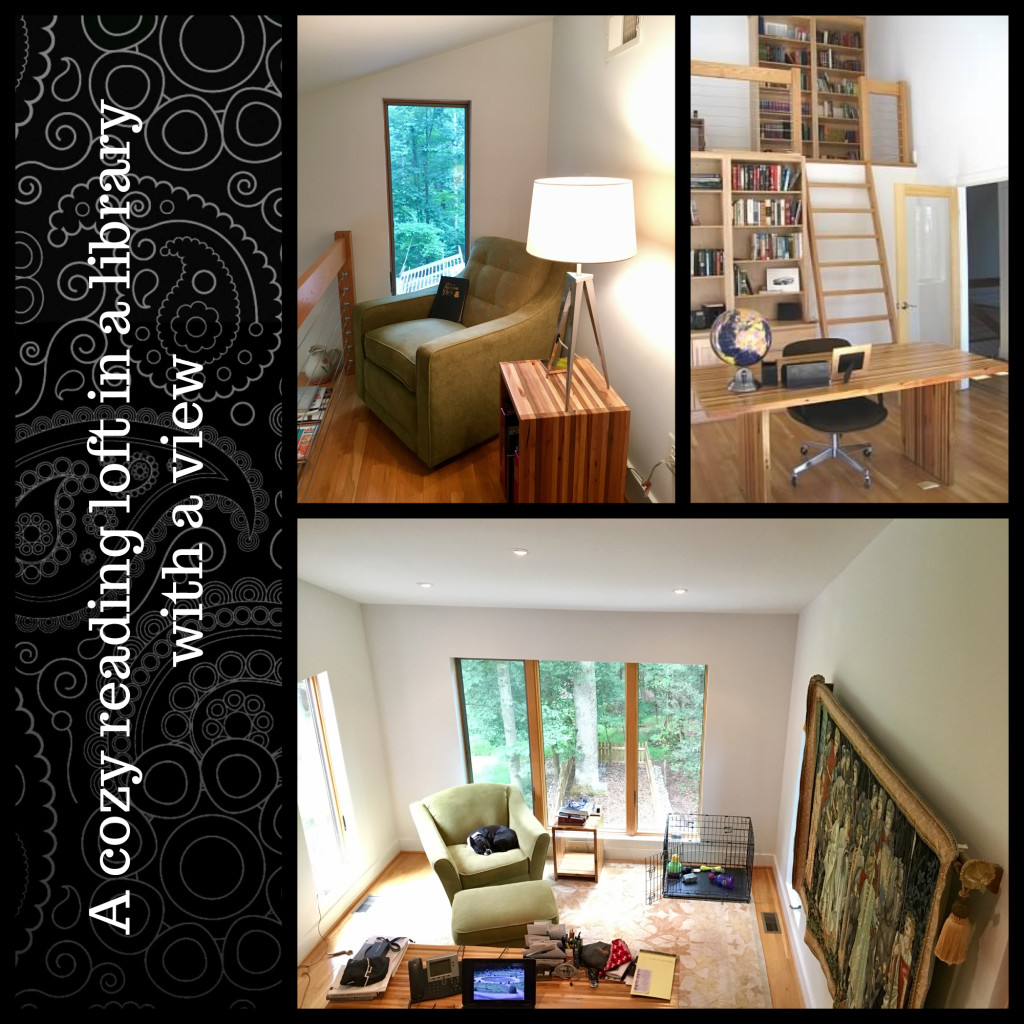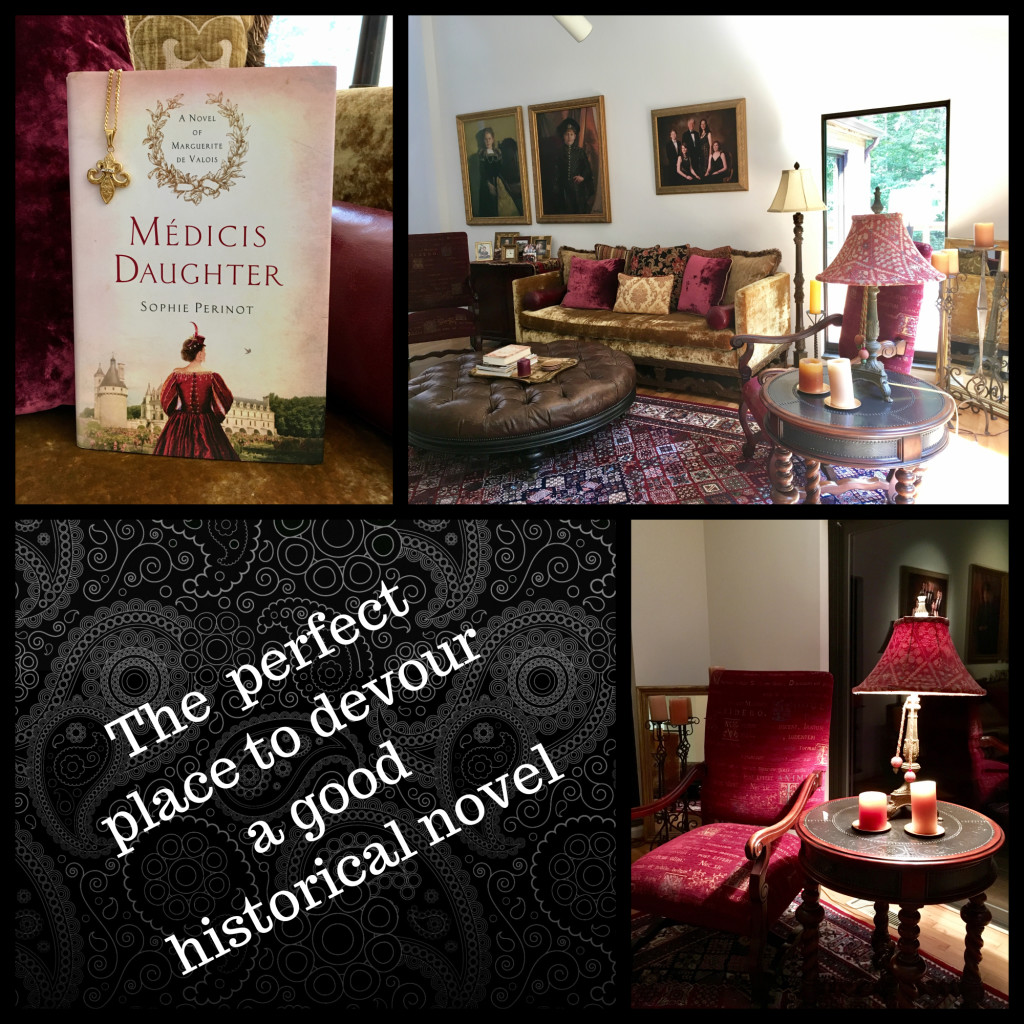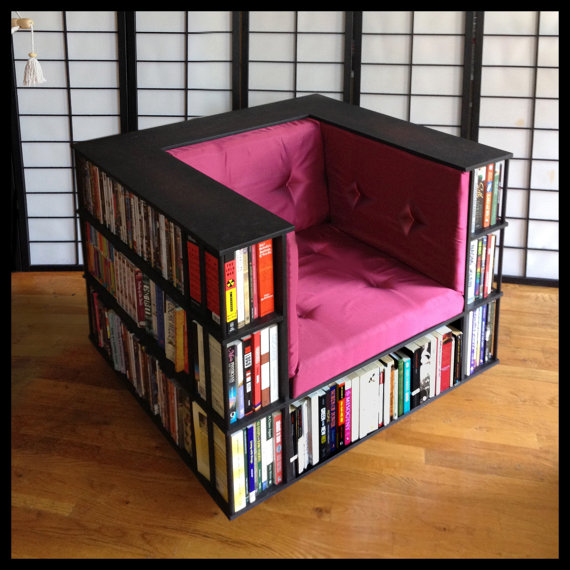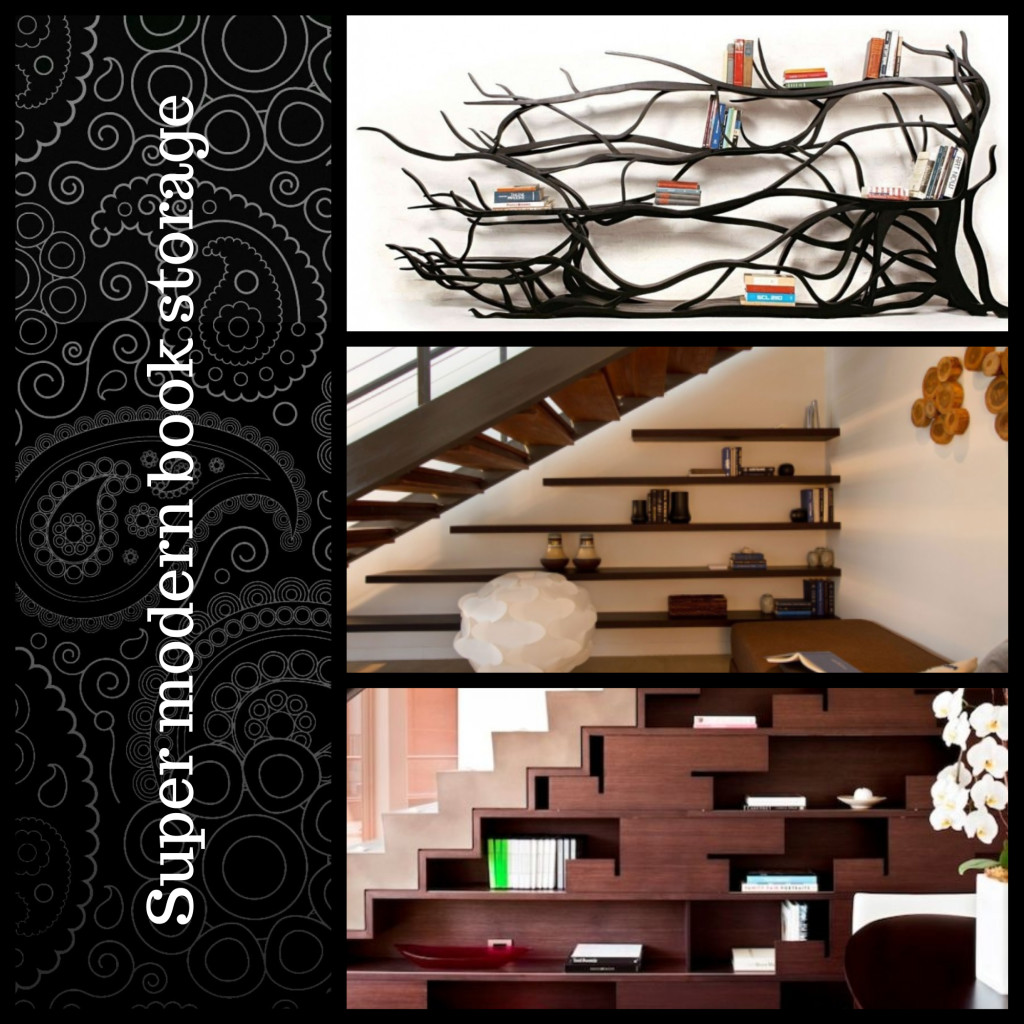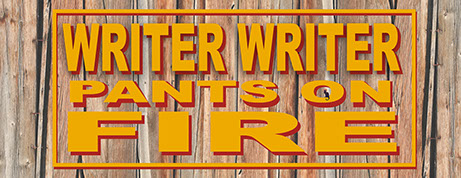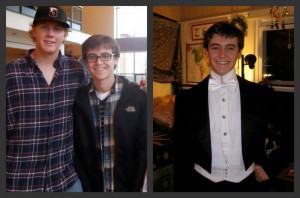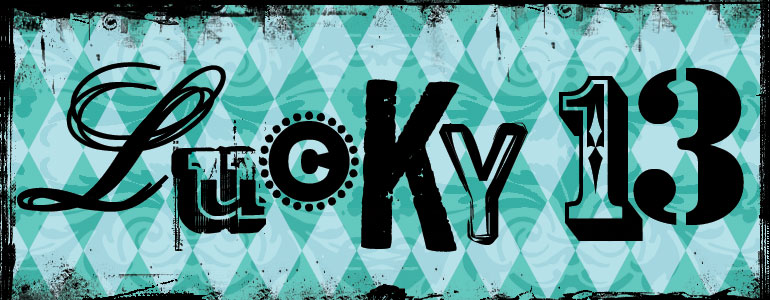Category: Tales From the Writer’s Life
An Amazing Time in San Antonio: The Historical Novel Society North American Conference 2023
Hello dear readers! I am just back from the biannual North American HNS conference. Bit of trivia—I’ve attended every American HNS conference since the very first, held in Salt Lake City in 2005. Back then I was still working on my first manuscript and had no agent yet. Over my three days in Utah and I learned so much about the industry! To this day I consider the HNS conferences an indispensable event for staying up to speed on the publishing industry and gaining insights into the craft of writing for those of us writing in the historical genre. They are also a heck of a lot of fun.
I was a panelist in San Antonio, discussing the logistics of pen names—their creation, branding and management—along with the talented Eliza Knight, Libbie Grant and Kris Waldherr. Our panel had a specific focus on using multiple pen names, which means I got to be both Sophie Perinot and Evie Hawtrey in the same place at the same time (a first)!
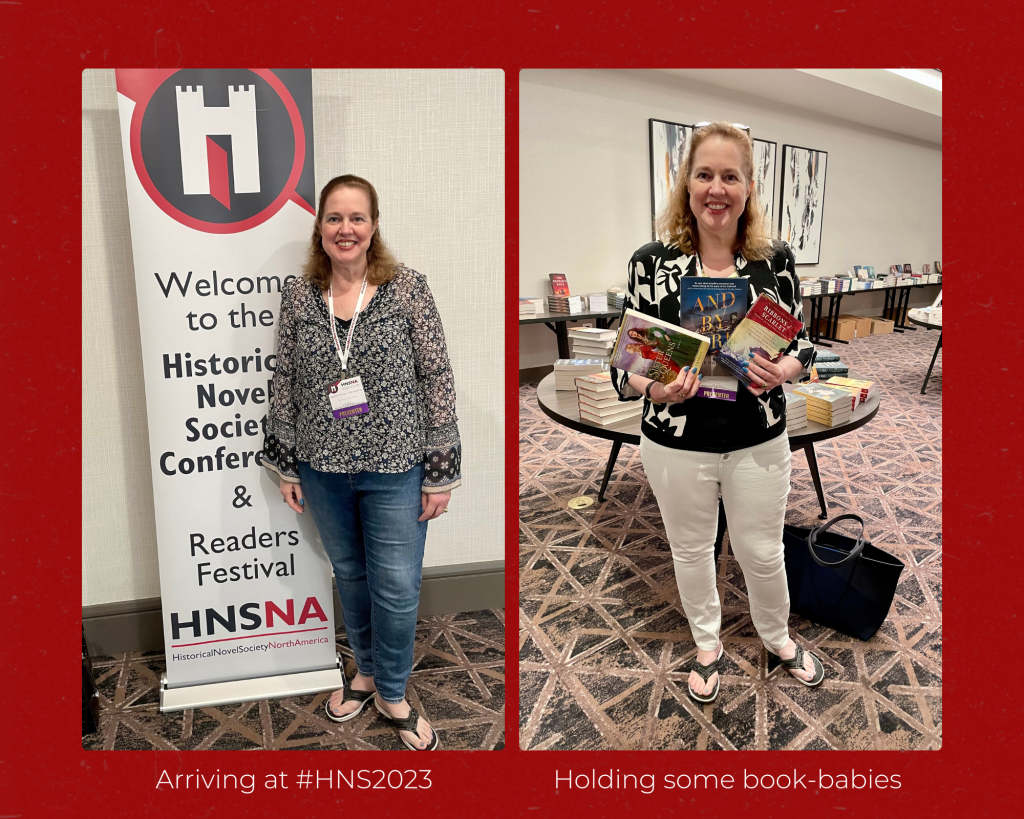
Below you will find some photo highlights of the conference, featuring myself and other historical fiction authors you likely read, as well some of what we got up to. Enjoy! I certainly did!

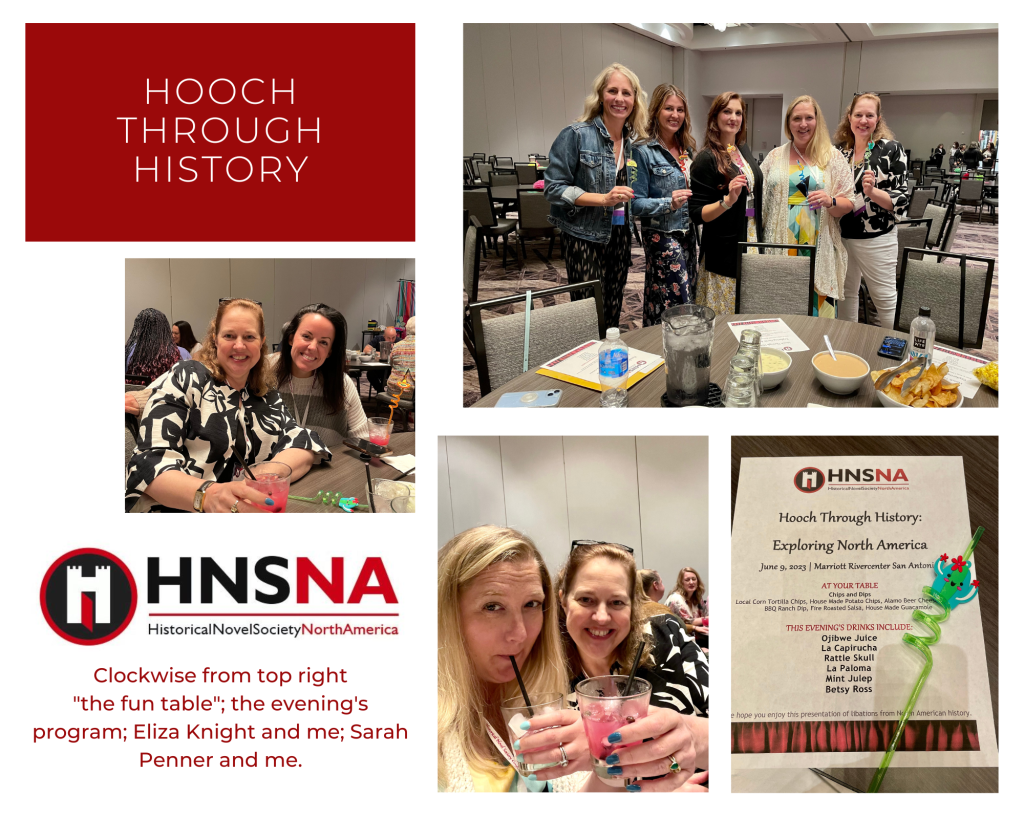
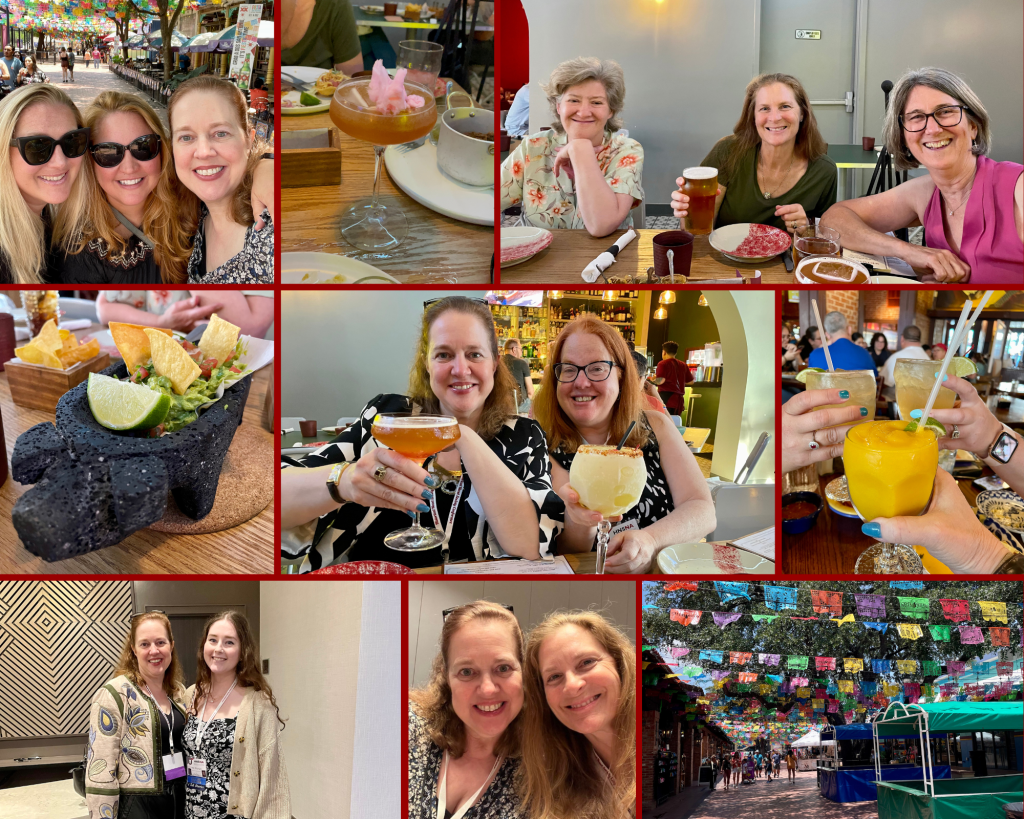
Clockwise from top left: Eliza Knight, Heather Webb and me; cotton candy cocktail; Mariah Fredericks, Karen Odden and Judith Starkston; margaritas; Karen Odden and me; Kate Khavari and me; best guacamole ever. And right smack in the center–Nancy Bilyeau and me.

There Are Now TWO of Me
There are now officially TWO of me—and there have been since last month when my debut crime novel And by Fire, written as Evie Hawtrey, hit shelves everywhere. Evie may write mystery, but she hasn’t abandoned history. And by Fire features a mystery set in 1666 London before, during and after the Great Fire as one of the book’s two timelines.
So why the genre jump? I sat down with fellow historical novelist Anne Easter Smith and did an interview for the Historical Novel Society discussing just that. You can read it here.
And when you are done, may I suggest you pick up a copy of And by Fire, meet the new me and more importantly Lady Margaret Dove—a woman of science in a time when there was no such thing and a Lady-in-Waiting to England’s queen, who goes looking for a friend disappeared as London burned and finds devilry and murder.
Sacred Spaces—One Writer’s Favorite Spots to Curl up with a Good Book
It is a truth universally acknowledged that a vast majority of writers are rabid readers. We were the kids who used to sneak in from recess and curl up somewhere with a book hoping nobody would catch us. We were constantly being admonished to “turn out that bedroom light and get to sleep,” and now relish the fact that in our own homes we can stay up reading as long as we like. We are devotees of words—the way they can be strung together, their rhythm, their power to conjure places we have never been while at the same time touching on experiences and emotions so intimate that it feels like they can see inside us.
I am no exception. And like most avid readers I’ve spent a lifetime seeking out and cultivating places to disappear into books. I consider these very special, almost sacred spaces: places where the light is right, there is quiet, and there is an atmosphere that encourages deep reading and reflection.
As a girl I spent hours in a hammock in my back yard—generally emerging with legs imprinted by the pattern of the woven rope. These days—perhaps because I live in the metro DC area where heat and humidity are a given for so much of the year—most of my reading gets done indoors. In my current home I have two favorite reading retreats that I’d like to share with you.
First there is our family library. I own more than 300 volumes (not counting my research books, or the books selected by my husband or children). These are books that I felt needed to be present in my home as touchstones for myself and as an easy temptations for my children. Favorites in my collection include: a complete leather-bound set of Dumas (grandfather of historical fiction) from 1893, my first edition of To Kill a Mockingbird, an early version of Victor Hugo, and, of course, the tattered volume of the complete works of Jane Austen that I re-read during every single exam period of my educational career.
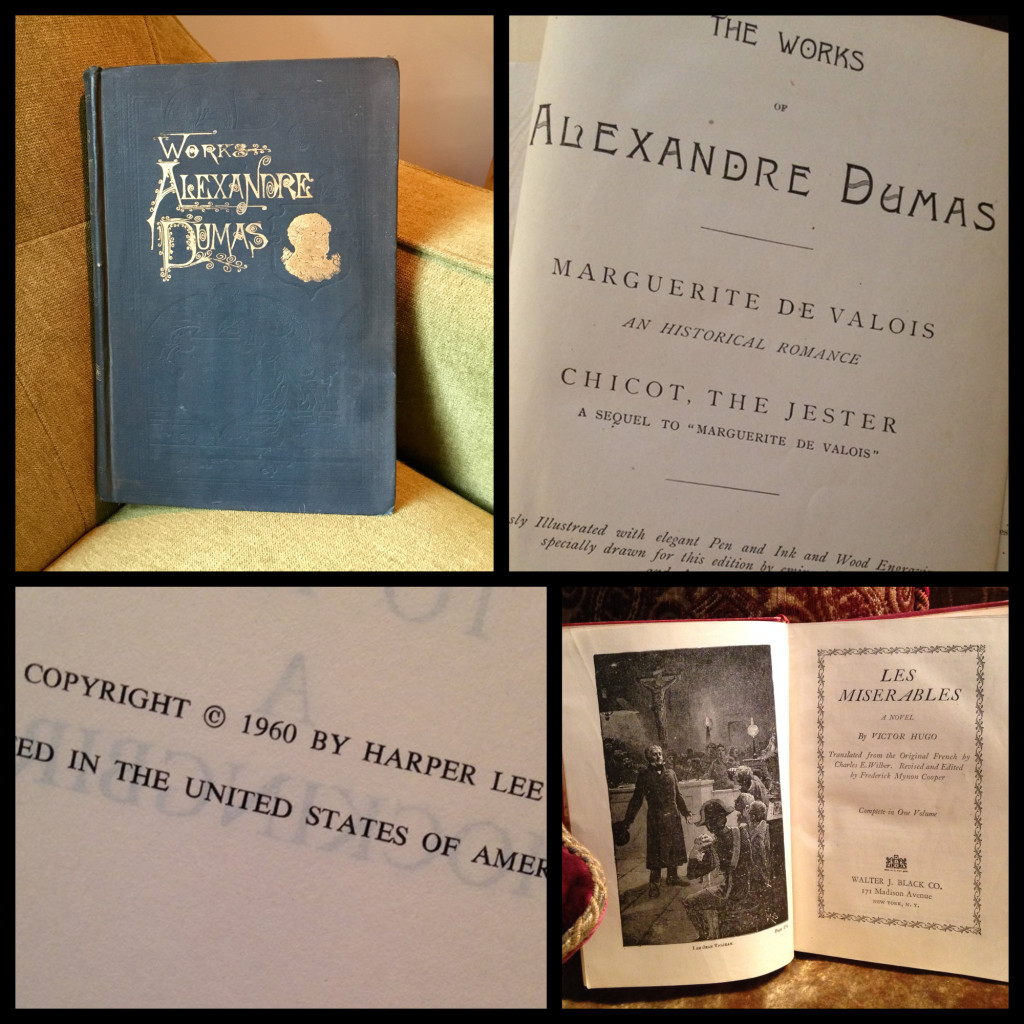
Below are some pictures of the library. One of the best places to get lost in a book is up the ladder in the loft. There is a wonderfully comfortable swivel chair with a commanding view and plenty of light (both natural and artificial) up there. It is quite possible to escape the notice of others in this sky-high reading spot. In fact, I’ve watched my husband come in and out of the room quite unaware of my presence.
The library with its modern, airy feel, isn’t my only sacred reading space. When I am interested in disappearing into the past with a good historical novel (often by one of my author friends), I prefer a more period setting.
Fortunately I’ve created a living room (sans television, obviously) with just the right feel. What I’ve tried to do with this space is conjure the feeling you get when your tour an ancestral home in France or England and rather than the “décor of the moment” you are treated to a layered atmosphere, developed over generations of a family’s presence and many lifetimes of collecting furniture and objects. The room features oil portraits of my children in period costumes spanning 1530 to 1582, old wood made into a bench, oriental rugs, and my favorite reading chair in the house—deep burgundy and covered in Latin. Voila!
This is the place I go to read books set in eras that I write about. And it was in this room that I opened up the boxes containing those always-exciting first copies of my novels including, most recently, Médicis Daughter—a 16th century coming-of-age story of the youngest Valois princess, weaving forbidden love with some of the most dramatic and violent events in French history—a book that Kirkus called, “A riveting page-turner skillfully blending illicit liaisons and political chicanery.” [You will notice the book in the collage above, perched on my delicious velvet pillow-smothered couch].
So those are my existing favorite reading spots, but I have one more dedicated reading space left to create. Soon I will be renovating an under-the-stairs space into a reading nook. The stairs in this part of my house are dark wood and floating (open tread). The space will absolutely be intimate. If I had the room I’d go big—look at this beauty, though I’d have to have it in dark wood!
But my bench or seat must run perpendicular to my stairs to fit the space (long story involving plumbing) so I only have about 43 inches. I am considering two options. The first is going modern as I did in my library. I love the chair idea below—bookshelves as both the base and the arms of the seat to maximize the ability to always have a good book handy!
Alternately I might keep shelving and reading separate. Arhaus has a great chair called the Nara that would be just the right size and I ADORE its velvety look and the warm paprika color! I would get the legs in chrome not brass (and the good thing is the chair is customizable so I don’t have to settle). Or maybe the yummy Clancy, which would feel like a sofa for one.
I could finish my modern look with some built-in under-stair shelves. I like all three of these, but the one with the branches—while perhaps less practical—is so unique as to be nearly irresistible.
My second option is to go with a more traditional/historical feel. What do you think of this Portsmouth chair in pewter? I am getting a very Jonathan Strange and Mr. Norrell vibe! The upholstery really appeals to me, and that comfy loose cushion could be adjusted just right for back or arm support).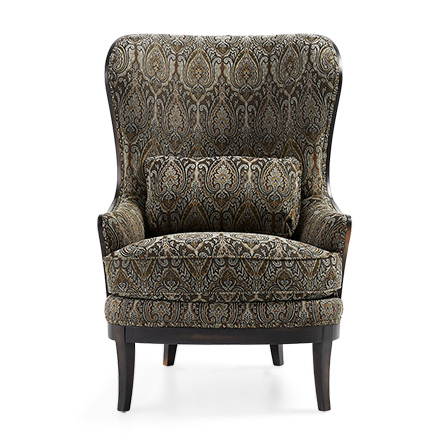
Either of these console tables in rustic black (both from Arhaus) could totally flesh out the early 18th century feel don’t you think?
So which look would you pursue for the under-stair nook if you were me dear fellow readers—the modern or the historical? Which of my existing sacred reading spaces do you like the best? What does your own special favorite reading space look like—either in your home or in your imagination?
Oh and if you are interested in the Arhaus pieces I featured in my idea boards, or just looking for inspiration for your own readings spot, you can find both right here in the living room section of their website.
My First Podcast: Have A Listen!
How long have I known Mindy McInnis, Edgar Award-winning author of YA fiction? Too long for me to fess up. But let’s just say we knew each other before we were agented let alone published!
Mindy runs an awesome blog for aspiring writers called Writer, Writer Pants on Fire, and a pod-cast of the same name which features interviews established authors taking about the nitty-gritty of the road to publication. TODAY I AM HONORED TO BE HER FIRST “ADULT” AUTHOR ON THE PODCAST (though I am not sure the label adult is entirely apt for me 100% of the time).
Interested in how I landed my agent, what my submission process was really like, why I tend to hop around from era to era when writing? Have a listen!!!
Fans Matter
Fans matter. I know I’ve said this before, but I am saying it again.
First and foremost you bring the characters to life. True, I write them, but if characters speak or acts on a page but nobody reads it they remain vision, vapor, not living and breathing flesh. Writing is solitary enough in the doing, the thought of the results going unread—that would turn solitude into loneliness. So THANK YOU for not letting that happen to my words.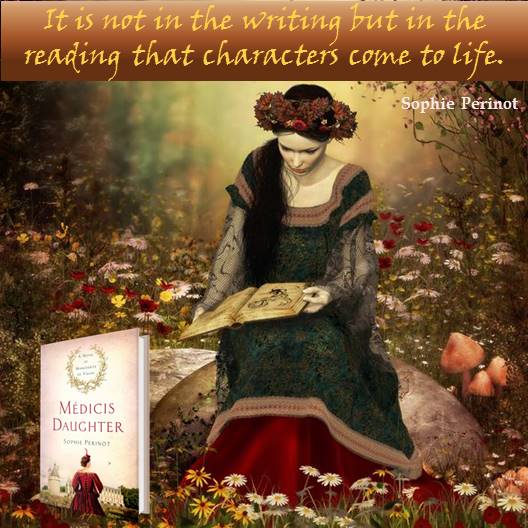
But if fans provide a reason to write they also give writers the ability to continue. Because this is a business, make no mistake about that. Our publishers are not just putting our books out there on charitable impulse. We measure up to whatever their goals for us are, or they move on. So when fans do a few simple things they support us in important ways. What simple things? Ha, aren’t you glad I asked for you?
1) Add the books of your favorite authors to your goodreads TBR pile. This is one click. Please click. Here is the link for Médicis Daughter
2) If you want to wait to pick up a book at a library that’s great. My first paid job was shelving non-fiction books at my local library. I love libraries. If, however, you are inclined to buy a book and you have the means to do so, pre-orders or purchases immediately after a book releases pack a whallop. Here’s my famous (infamous) blog on that subject.
3) Review. It doesn’t have to be two paragraphs. It can be two lines. You don’t need to post everywhere. But sharing what you thought of my work—or any author’s work—at a couple of locations if you have an on-line presence . . . no greater gift my friends.
4) Recommend. Readers talk books. We can’t help it. And we should not try to. Word of mouth remains the most powerful tool for helping good books to do well. Reader enthusiasm is contagious. So mention books you like to other bibliophiles. Your author friends will bless you.
Couldn’t Make It to the Baltimore Book Festival—Never Fear, Post Festival Blogging Is Here
As many of you know I was a presenting author at the recent Baltimore Book Festival. This gave me a chance to participate in a number of compelling author panels, two of which have now led to blog posts. So if you weren’t able to make it to Charm City, here’s your chance to read about the discussions you missed.
Reinventing yourself as an author? You can read my thoughts on why it is vital to find the guts to admit you want your writing to be more than a hobby at Book Pregnant where I’ve posted a discussion of “Finding the Courage to Write” based on my panel of the same name.
Fan of historical fiction? If you are a reader or writer of historical novels you may be interested in my guest post today at In the Hammock, where I consider whether Historical Fiction is Women’s Fiction—or more precisely where and why I believe the two genres intersect. This is an issue I’d never given serious thought before being assigned to the “What is Women’s Fiction” panel in Baltimore.
Please stop by either or both blogs and join the discussion!
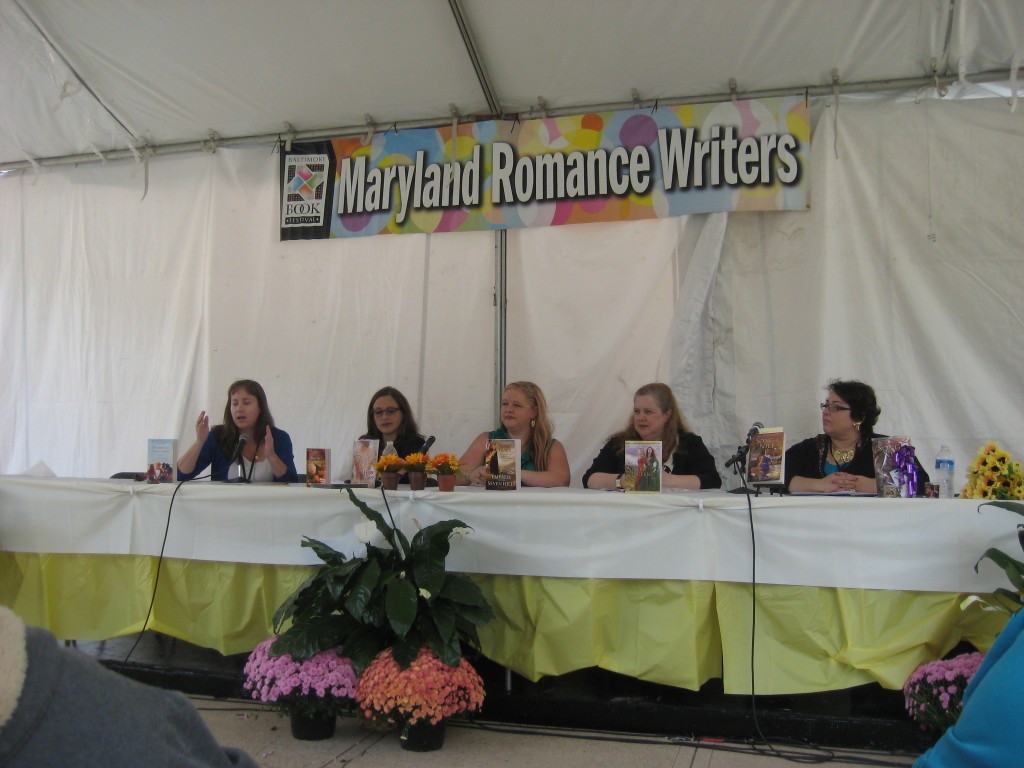
Tagged: The Next Big Thing – Find Out What I am Working on Now
I’ve been tagged by the talented historical thriller writer Nancy Bilyeau (author of The Crown) in a blog game called The Next Big Thing. The game involves authors answering questions about their work in progress (aka WIP). So I am “it” for the moment, and I am off to the 16th century to talk about the mother-daughter story I am writing. Come along! Will my WIP be the next big thing? I sure hope so, but only readers can make that decision.
Here we go. . . my answers to the OFFICIAL “Ten Questions for The Next Big Thing”:
1. What is the working title of your book?
Daughter of de Medici
2. Where did the idea come from for the book?

It sprang from the intersection between two strong personal interests. First, I have been fascinated with the Valois royal line since I read Alexandre Dumas’ book La Reine Margot as a teen, and I’ve been particularly obsessed with the oft maligned Marguerite de Valois, youngest daughter of Catherine de Medici and Henri II of France. Second, I have a preoccupation with the relationships that shape women’s lives—especially formative female-to-female relationships. Daughter of de Medici unites those two interests by exploring the sacred, complicated and oh-so-seminal mother-daughter relationship with Marguerite de Valois and Catherine de Medici as main characters.
3. What genre does your book fall under?
Historical fiction. I just can’t imagine writing about the present.
4. Which actors would you choose to play your characters in a movie rendition?
I would cast Keira Knightley to play Marguerite as she has both the beauty (Marguerite was often called the loveliest woman in France) and the depth for the role. If Keira was busy I’d cast Natalie Portman. I’d want Virna Lisi to play Catherine de Medici because she did a breathtaking job in that role in Patrice Chéreau’s 1994 film La Reine Margot.
As for the men in Marguerite’s life, I would cast Benedict Cumberbatch as Henri, Duc de Guise (Marguerite’s first love) or Robert Pattinson if Benny is deemed too old. I’d choose Joseph Gordon-Levitt as Marguerite’s older brother Henri, Duc d’Anjou (future Henri III of France) and Nicholas Hoult as her younger brother François, Duc d’Alençon. I am genuinely stumped on casting Henri de Navarre (Marguerite’s husband and the future Henri IV of France). I am sure the moment I post this I will think of THE perfect casting but for now I’d probably choose Jesse Eisenberg or Anton Yelchin.
5. What is the one-sentence synopsis of your book?
Not really a synopsis—more of a tag line: “Every mother-daughter relationship is fraught with peril. Her mother was Catherine de Medici.” Continue reading Tagged: The Next Big Thing – Find Out What I am Working on Now
Summer Time and the Livin is Easy? NOT
Yes, it has come to this. I am so exhausted from all this “summer vacation” that the lyrics from Porgy and Bess make me ornery. I could have told you – even without looking it up – that the person who wrote the lyric “Summer time and the livin is easy” was a MAN. Sure enough, it appears author DuBose Heyward who wrote the novel that the opera is based upon penned that line. 
Let me tell you Mr. Heyward, as an author and a mother that line of prose makes diet coke squirt out of my nose in a most unbecoming way. If, like me, you combine writing with mothering all from the same location (home) then summertime is a marathon—a marathon that your muse is bound to lose. Can I get an amen from the other writing mom’s out there?!
Unless you ship your kids off to sleep-away camp there will never be a more chaotic time for writing than summer “vacation” (well I suppose trying to write during a family crisis would be worse but let’s hope that isn’t as common an experience as summer-vacation writing is). The school year schedule may provide short writing days, but those truncated days are blessedly quiet. And they are relatively uninterrupted, except when the fridge is bare and the shopping must be done or one’s spouse declares he is wearing absolutely his last pair of clean undies so you spend half the day running up and down stairs to your laundry room.
During the school year if I am writing well I don’t eat lunch. During the summer it doesn’t matter how well I am writing, my elementary aged-son son is going to get hungry. And he, not unreasonably, is going to want to spend some time with me (unless he is avoiding doing his daily math and in which case I am going to go looking for him, muse be damned). Summer’s short windows for writing tend to provide just enough time for me to get into a scene before, voila, it is time to stop. Someone always needs picking up somewhere (the metro station, a lesson, day camp) and the fear of forgetting a child somewhere looms even larger than the fear I am never going to finish this manuscript. So I leave the fantastic paragraph unfinished and jump in the mom-mobile.
Yes Sophie you say – nodding your head in maternal commiseration—but where is all this whining going to get you?
NOWHERE. And that is the point (you were hoping I had one weren’t you). Being frustrated never got a chapter finished, and it sure sucks the fun out of cookie-making or crafts. As I see it we (the mass of mom’s with kids home for at least a few more weeks who are desperately trying get some other sort of work done) have a couple of choices:
We can try to be supermoms. We can get up to write before the kids awake; work after their bedtimes; and make ourselves jot down a sentence or two while waiting in the camp carpool line. This is a necessary approach for those of us on deadline, and it works wonders for some writers– but it is ONLY if they are the type of person who can write under that sort of pressure (and at odd hours). Staying up past your bedtime is not a winning strategy if you are prone to waking at 3 a.m. in a pool of drool on your own manuscript.
We can get away. Probably not for the whole summer, but if you are the type of writer who works best in long stretches and relative quiet, what about grabbing a long weekend here or there? Tell your husband “you’re it” and head to a friend’s guest room or somewhere more glamorous (funding permitting). If I had this summer to so all over again, I would take a whole week for myself. I’d put my college girl in charge of my younger kids, tell my husband to feed the family take out, and head for the hills. There’s always next summer . . .
We can cut ourselves some slack. We can accept the rhythm and writing-rate that a summer with children at home imposes and shrug, muttering “I can only do what I can do” under our breaths. Ultimately (after 3 rounds of out-of-town guests, 4 different types of camps, etc) this is what I am doing. You see I had an epiphany while on my real vacation. By the time I hit the beach last week I was as crabby as a two-year-old kept up for 36 hours straight and only given junk food. I wasn’t enjoying my writing. I wasn’t enjoying my kids. And I KNOW I was inflicting collateral damage on the rest of my family (because hey, to quote something I read in a Washington Post editorial years ago, “if mama ain’t happy, ain’t NOBODY happy). I looked at myself in the mirror and thought, it’s August, you didn’t write as much as I thought I would this summer. Get over it and enjoy the weeks you have left before school starts.”
I am I disappointed in myself? What good would that do? There is enough needless worrying and unearned guilt in mothering at the best of times, and plenty in writing as well. Besides, the book will get done. To circle back to Porgy & Bess (with a few changes):
One of these mornings, I’m gonna rise up singing. I’m gonna spread my wings and take to the sky.
I suspect that morning will come the Tuesday after Labor Day. I imagine I’ll see plenty of other writer-moms up in the clouds that day as well.
Clothing Makes the Man (or Woman) – A Plea for a Return to A More Civilized Dress Code
I’ve been thinking about the power of clothing.
I do this a lot because I am both a) rather strangely obsessed with historical clothing and b) profoundly dissatisfied with how we dress in modern times. Look around you – almost nobody looks spiffy. Rather, nearly everyone looks like they thought they would be spending the day lolling about on the floor of a college dorm room ( even the 50 year old executives on the metro on “casual Friday”) or like they’ve been under the weather so they never quite got out of their sweats.
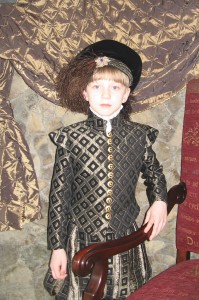
It used to be that clothes reflected a person’s status. Sumptuary laws made certain that only those at the top of the pecking order were allowed to wear certain materials. You knew a king when you saw one. I am not advocating a return to class-distinction by wardrobe. By no means. But who would have predicted when dress was democratized that a race to the bottom would begin? Yet today, after hundreds of years during which tradesmen and later the middle class tried to dress up a socio-economic level (or two), people willingly leave their homes in such a slovenly state that, but for their hygiene and the fact they have their teeth, they could pass for peasants.
All this “casual” dress is done in the name of comfort, but there is no reason in the world why nice, properly pressed clothing can’t be comfortable. And if it is not as comfortable as just throwing on any old rumpled thing, isn’t personal pride worth a modicum of sacrifice?
Yesterday over at Steampunk.com there was a discussion of the 2013 Prada Fall/Winter line. They were, of course, interested in the steampunkiness of the collection but I saw lots of historical references in the garments. I was struck by just how good the models all looked—even Willem Dafoe who has looked slightly seedy and decrepit for years. They look powerful, confident, sharp and generally more attractive then when you see them in modern clothing (go ahead, Google Gary Oldman and compare an image of him in street clothing to those of him in the Prada). This confirmed something I’ve suspected for a long time—almost everyone looks better “dressed-up” (as in properly, neatly and relatively formally attired).
If you want further proof compare pictures from people in your own life when they look “thrown together” with those where they are “sharply dressed.” I mean there is a reason we tend to put on more formal clothing for auspicious occasions—we want to look our best. You didn’t wear flip flops, sweats and a tee-shirt for your wedding right? (please, PLEASE tell me you didn’t). To illustrate my point, here are two pictures of the same young man (a daughter’s boyfriend). In the first he is dressed in typical college wear, in the other in a vintage bespoke 1939 tailcoat. Not close is it?
I concede (though it gives me no pleasure) that the days of dressing for dinner are past, and that going back to styles which require the assistance of a valet or ladies maid is out of the question. But surely it is not too late to bring back pride in personal appearance and the idea that different clothing is appropriate for different settings (work vs. cutting your lawn)?
Maybe what we really need is this fellow. Is he rude in this sketch—yes. Is it meant to be funny—of course. But have we all seen people dressed like this and thought they were “a turd”—I sure have.
Lucky Thirteen – Thirteen Things I am Grateful for on the Thirteen-Week Anniversary of The Sister Queen’s Release
For the superstitious, thirteen is hardly an auspicious number. And, as those of you who’ve read my blog post at Book Pregnant know, a novel more than three months past its release can start to get lost in the shuffle, leaving its author with a case of the not-so-new-anymore blues. Call me a cockeyed optimist but I choose to face the thirteen-week anniversary of the release of The Sister Queens with a list of thirteen reasons (in no particular order) that I am grateful to be JUST WHERE AND WHEN I AM.
1. My day started with this touching shout out from fellow writer Joey Francisco. Joey reminds us that reading can transport people—even people oppressed by pain and illness—and she challenges authors to “pay it forward” by donating a copy of their work to the book cart at their local hospital. What a timely reminder of the magic of fiction, and what a fantastic service idea!
2. Reviewers have been generous. To date The Sister Queens has received more than three-dozen very positive reviews. Most recently, The School Library Journal declared:
Word on the street (rather, consensus among historical fiction bloggers) is that this is an author to watch whose book is a page-turner, fast-paced, emotional, passionate, well-written and carefully researched.”
3. The Fans are FANTASTIC. I am constantly hearing from new people who love my book and support my writing. Readers, your notes, direct messages, and tweets mean so very much. Thank you. Thirteen weeks on, I am still receiving photos from Queen Spotters around the country. Got another picture of The Sister Queens lounging on a bed inMaine just this past weekend.
4. I’ve been invited to be a Presenting Author at the 2012 Baltimore Book Festival. What better way to spend the last weekend in September? I will be participating in a number of panels including a discussion of “Trends in Historical Fiction” and (oh JOY) a reconstitution of the “Sex and the Historical Novelist” panel that Kate Quinn, Stephanie Dray and I created for our triple-author appearance in April
5. I hit my all-time high Amazon ranking for The Sister Queens in trade paperback on my twelve-week anniversary! Looks like buzz is building sales even if The Sister Queens is not a “new release” anymore.
6. High fives, hand-holding and the occasional shoulder as needed from fellow writers make a solitary profession less so. I’ve never been in a more supportive profession. From the marvelous writers whose blurbs grace The Sister Queen’s cover, to the twenty-nine fellow members of my debut author group, Book Pregnant, the past thirteen weeks have been full of fellow writers willing to lend an ear or a hand as I navigated my debut. Talk about renewed faith in mankind.
7. Team Sophie rocked the postcards. Team Sophie is made up of readers who signed on to share their enthusiasm about The Sister Queens. Their first mission was mailing a few custom postcards to recommend the novel to friends. Team S, you all made a serious dent in my pile of postcards 🙂 and I don’t doubt for a moment that the buzz you generated caused an uptick in sales.
8. Book clubs made me feel welcome. I am now a book-club veteran with both live and skype appearances under my belt (here’s a picture of the Georgia club that provided my first skype date). A chance to discuss the themes and characters in my novel—that’s like chocolate, red wine and good sex all rolled into one. Bless you book clubs. Bless you.
9. My wip (work in progress) feeds my need. Sometimes I love it. Other times . . . it makes me feel like I am trapped under something heavy. But the truth is I can’t live without the magical time-traveling rush I get from writing. So I am happy for my current manuscript which keeps me cocooned in the 16th century.
10. My family reminds me there are more important things in life than how many words I write each day. When the muse doesn’t cooperate and I descend from my office grumpy and fershimmeled the faces of my husband and children remind me the day is still a success in other, more important, ways. And when the muse does cooperate and I forget about making dinner, I am grateful that my family rolls with it (generally) without complaint.
11. The twenty-five readers who reviewed The Sister Queens on Amazon, and the many more who reviewed it on Goodreads took the time to make a difference. You have powerful voices and help others make reading and purchasing decisions. Particularly at Amazon your numbers move algorithms, influencing how often and where my book is recommended to other visitors. Thanks!
12. Nearly 300 people have “liked” either my book page or my author page at Facebook 🙂
13. My agent and my editor had faith in me (and in The Sister Queens). That faith permitted me to step on the roller-coaster that is publication. It’s been a wild ride so far, but I haven’t thrown up yet! That’s something isn’t it?
Here’s to the next thirteen weeks with all their triumphs and trials!
